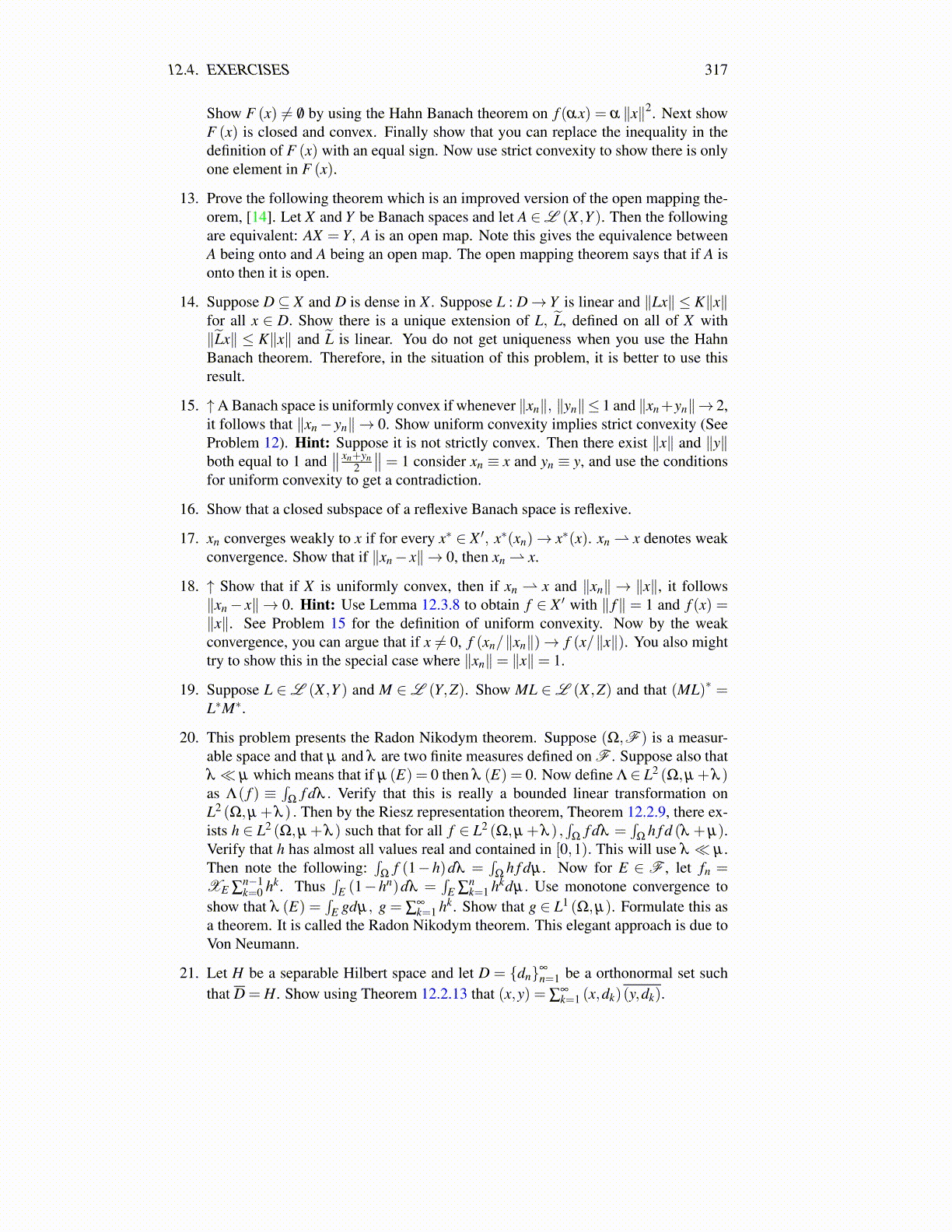
12.4. EXERCISES 317
Show F (x) ̸= /0 by using the Hahn Banach theorem on f (αx) = α ∥x∥2. Next showF (x) is closed and convex. Finally show that you can replace the inequality in thedefinition of F (x) with an equal sign. Now use strict convexity to show there is onlyone element in F (x).
13. Prove the following theorem which is an improved version of the open mapping the-orem, [14]. Let X and Y be Banach spaces and let A ∈L (X ,Y ). Then the followingare equivalent: AX = Y, A is an open map. Note this gives the equivalence betweenA being onto and A being an open map. The open mapping theorem says that if A isonto then it is open.
14. Suppose D⊆ X and D is dense in X . Suppose L : D→ Y is linear and ∥Lx∥ ≤ K∥x∥for all x ∈ D. Show there is a unique extension of L, L̃, defined on all of X with∥L̃x∥ ≤ K∥x∥ and L̃ is linear. You do not get uniqueness when you use the HahnBanach theorem. Therefore, in the situation of this problem, it is better to use thisresult.
15. ↑A Banach space is uniformly convex if whenever ∥xn∥, ∥yn∥≤ 1 and ∥xn+yn∥→ 2,it follows that ∥xn− yn∥ → 0. Show uniform convexity implies strict convexity (SeeProblem 12). Hint: Suppose it is not strictly convex. Then there exist ∥x∥ and ∥y∥both equal to 1 and
∥∥ xn+yn2
∥∥ = 1 consider xn ≡ x and yn ≡ y, and use the conditionsfor uniform convexity to get a contradiction.
16. Show that a closed subspace of a reflexive Banach space is reflexive.
17. xn converges weakly to x if for every x∗ ∈ X ′, x∗(xn)→ x∗(x). xn ⇀ x denotes weakconvergence. Show that if ∥xn− x∥→ 0, then xn ⇀ x.
18. ↑ Show that if X is uniformly convex, then if xn ⇀ x and ∥xn∥ → ∥x∥, it follows∥xn− x∥ → 0. Hint: Use Lemma 12.3.8 to obtain f ∈ X ′ with ∥ f∥ = 1 and f (x) =∥x∥. See Problem 15 for the definition of uniform convexity. Now by the weakconvergence, you can argue that if x ̸= 0, f (xn/∥xn∥)→ f (x/∥x∥). You also mighttry to show this in the special case where ∥xn∥= ∥x∥= 1.
19. Suppose L ∈L (X ,Y ) and M ∈L (Y,Z). Show ML ∈L (X ,Z) and that (ML)∗ =L∗M∗.
20. This problem presents the Radon Nikodym theorem. Suppose (Ω,F ) is a measur-able space and that µ and λ are two finite measures defined on F . Suppose also thatλ ≪ µ which means that if µ (E) = 0 then λ (E) = 0. Now define Λ ∈ L2 (Ω,µ +λ )as Λ( f ) ≡
∫Ω
f dλ . Verify that this is really a bounded linear transformation onL2 (Ω,µ +λ ) . Then by the Riesz representation theorem, Theorem 12.2.9, there ex-ists h ∈ L2 (Ω,µ +λ ) such that for all f ∈ L2 (Ω,µ +λ ) ,
∫Ω
f dλ =∫
Ωh f d (λ +µ).
Verify that h has almost all values real and contained in [0,1). This will use λ ≪ µ .Then note the following:
∫Ω
f (1−h)dλ =∫
Ωh f dµ . Now for E ∈ F , let fn =
XE ∑n−1k=0 hk. Thus
∫E (1−hn)dλ =
∫E ∑
nk=1 hkdµ. Use monotone convergence to
show that λ (E) =∫
E gdµ, g = ∑∞k=1 hk. Show that g ∈ L1 (Ω,µ). Formulate this as
a theorem. It is called the Radon Nikodym theorem. This elegant approach is due toVon Neumann.
21. Let H be a separable Hilbert space and let D = {dn}∞
n=1 be a orthonormal set suchthat D = H. Show using Theorem 12.2.13 that (x,y) = ∑
∞k=1 (x,dk)(y,dk).